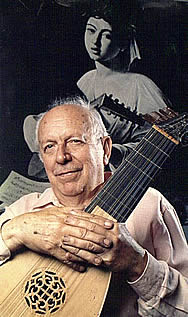When he was a boy, José Yacoppi learned that in life, you don't need much to survive. Every time his father--a guitarmaking luthier like him--was chased by Franco's men in Spain, the Nazis in France and the war in Europe, he learned that a workshop had to fit into a valise, and the life of an entire family could depend on one guitar. Every time they had to move all they had to take with them was a finished instrument so that José could show his art and get supporters until he could begin anew. In 1949 he arrived in Argentina and opened his shop on quiet San Fernando street.
"My 84th birthday was on the 28 of December [2000]. People call on the phone and say, 'yes, can I speak to José Yacoppi?" and I say, "yes, speaking." They're surprised. They don't say it, but I can listen to the tone of their voice, "but how can that be? He's still alive?"
It's best you know from the start: the best of Yacoppi, after his guitars, is his black humor. He's been exporting guitars to Japan at a pace of 25 a year. "Look, I know there are a bunch of my guitars out there, and when I'm dead, their price is going to rise. Outside Argentina, my guitars sell for high prices. Do you know Eric Clapton? He bought a Yacoppi in Germany three years ago and paid seven thousand dollars. And at the Sotheby's auction house in London, he knocked down a 1950 Yacoppi after paying ten thousand dollars. I wish I had one to sell. It's that in 1950 I was very young, and what was I to guess, that my shop would eventually become so highly regarded. I also never thought I'd live so long. Look, once I even made a vihüela, the grandmother of guitars, that one over there..."
He walks to a showcase and takes out a vihuela, a large instrument studded with mother of pearl.
"The amount of work on this is so monstrous, so huge, that I hardly can believe it was me who did it. Once I took it to Europe. I told myself, "I'm going to kill with this one." He took it to Sotheby's and someone there said, "Oh, how pretty. Who made it?" "Me." "Oh, but you're alive." I say, "Yes, I'm alive." And he says, "Oh, no, you've got to be deceased." I told him, "I'll shoot myself and come back."
Jose Yacopi passed away on the 11th of August of 2006.
Jose Yacoppi



